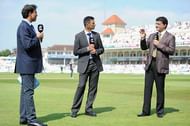More journalists as commentators

Cricket commentary, particularly in India, has reached new lows in recent times. Not only have the BCCI censored all commentary, with the threat of exile, the quality of the content itself is usually very poor.
With respect to classic cricket commentary, one usually thinks of Richie Benaud, Tony Cozier, and Harsha Bhogle. The gravitas with which they brought the game to life was unparalleled. They knew how to make a boring passage of play interesting with valid stories and how to do justice to a thrilling contest without screaming into a microphone.
Those days are gone. Nowadays, commentary, with a few exceptions, is completely overrun by ex-players, all of whom have either a political directive (in the case of Ravi Shastri and Sunil Gavaskar, who are directly hired as BCCI spokesmen), or are inexperienced in the role and have too many ties in current world cricket to be objective third eyes, like Michael Clarke.
Often, commentators are simply not well trained, not knowledgeable enough and engage in tired and awkward chit-chat that is either extremely partisan, vague or simply irrelevant. Commentary nowadays targets the stupid fan, spelling out what has just happened, talking in fear of silence.
Commentary desperately needs an injection of professional journalists, podcasters, analysts or even presenters like Mark Howard, who stimulate interesting conversation. Having former players does enhance things by way of interesting cricket stories and expert analysis, but the players need to be fluent in the language they are commentating in, well-trained and experienced, without having conflicts of interest. Ian Chappel, Richie Benaud and Ian Bishop are notable examples of this.
Essentially, a balance must be reached. The three-person commentary team can contain one or two experts, who are ex-players, but it must also have a minimum of one career journalist, historian or presenter, to give cricket broadcasting the class it deserves.
Follow IPL Auction 2025 Live Updates, News & Biddings at Sportskeeda. Get the fastest updates on Mega-Auction and cricket news
